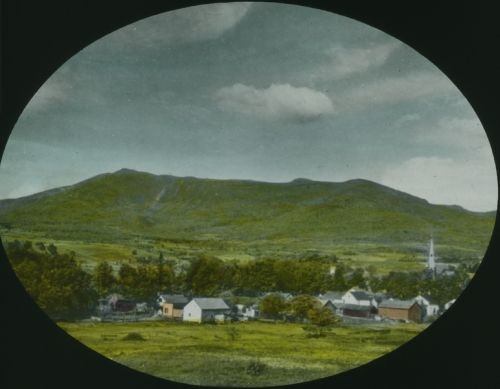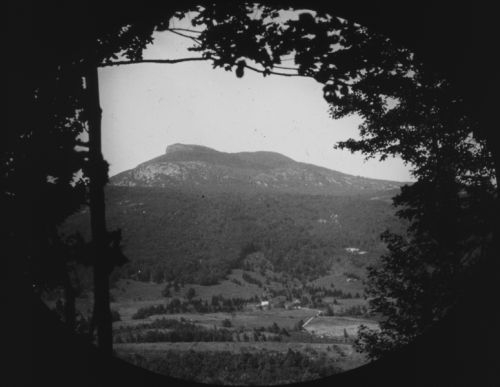Visit the Series Homepage
The Long Trail: Vermont’s Footpath Through History

(Host) We return now to our series, "The Long Trail: Vermont’s Footpath Through History."
The trail snakes through forests and marshes and crosses countless mountaintops and lookouts on its 270-mile route across the Green Mountains.
Two of the state’s most famous summits are connected by the Long Trail. But as VPR Commentator Tom Slayton explains, the mountains couldn’t be more different.
(Slayton) This is a tale of two mountains. One is Mount Mansfield, the highest peak in the state; the other is Camel’s Hump, its neighbor 30 miles to the south. They are two of the most distinctive mountains in Vermont, alike in being big, rock-capped, and beautiful, but different in their human history – and so today they present us with very different aspects – different personalities, if you will.
The quickest way to draw the distinction between them is to point out that Camel’s Hump is completely wild and Mount Mansfield is not. Mansfield is one of the most highly developed mountains in the state, while Camel’s Hump sits in the midst of a wild forest preserve that has never been developed and which the State of Vermont has pledged never will be.
(Mansfield tower work)
It should be said that despite the telecommunications towers, and workers, like these, on part of its summit, and large ski complex on its eastern slopes, Mount Mansfield’s western slope and most of its summit ridge remain open and undeveloped. It is still a grand, spectacular mountain with plenty of untrammeled territory on and around it.
(air ambi off summit)
 It’s windy up here but Camel’s Hump is truly wild – the only major mountain in Vermont completely free of ski lifts and radio towers. Writer, teacher and environmentalist John Elder of Middlebury College reflected recently on the historic importance of Camel’s Hump:
It’s windy up here but Camel’s Hump is truly wild – the only major mountain in Vermont completely free of ski lifts and radio towers. Writer, teacher and environmentalist John Elder of Middlebury College reflected recently on the historic importance of Camel’s Hump:
(Elder) "Historically, Camel’s Hump is also a monument to the vision of Joseph Battell, who in the end of the 19th century bought a lot of mountainous land precisely to protect it from the rapacious cutting that he’d seen all around him in the Green Mountains. So when we look at Camel’s Hump we have a legacy not only that’s not only a natural legacy, but a legacy of a certain kind of thinking that has made Vermont what it is today."
(Slayton) The Long Trail — Vermont’s special "Footpath in the Wilderness" — that follows the Green Mountains from Massachusetts to Canada, links Mansfield and the Hump. You can, without too much trouble, walk the 30 or so miles between the two summits in less than a week.
Mansfield is spectacular and grand; its bare summit ridge extends for more than a mile, providing ever-broader views as it rises in waves of sedges and stone. By contrast, Camel’s Hump is subtle and elegantly reclusive.
Hikers, like these, reach its open, rocky summit only after hiking more than three miles through unbroken forests.
Everyone is attracted to "highest" mountains, and Mansfield is no exception. More than 40,000 people a year attain its summit, either by hiking or driving up the toll road. And because its eastern ridges form a great snow-collecting bowl, it has been the site of a ski area since the earliest days of the sport. Gondolas like this one bring skiers in the winter and visitors in the summer.
(Mansfield gondola)
(Slayton) Skiing is a wonderful sport, and a true part of Vermont’s sporting heritage, but it is impossible to look down from the mountain’s summit crags at the conglomeration of lodges, condominiums, parking lots, and restaurants at its base -or at the telecommunication towers clustered around the Nose–and not feel that the wild essence of Mt. Mansfield has been deeply compromised.
(wind of camels hump)
The view from Camel’s Hump also offers plenty of evidence of the march of civilization – Interstate 89, a four-lane superhighway, slices through the Winooski Valley just to the north.
But the overall feeling atop the Hump is one of being somehow apart, elevated above the wide forest and the rolling Vermont landscape on a high stony pedestal, in the center of a great green and blue mandala.
John Elder says that is deeply important for Vermonters as well as Vermont:
(Elder) "There are many advantages to our modern connected world, but from time to time we need to be able to step back and hear the wind and also to encounter the free flow of our own thoughts, so that we can come back to our day-to-day lives and our work refreshed, because we live once more in a larger world."
(Slayton) Mt. Mansfield remains a grand and glorious mountain, and the activities there are an important part of today’s Vermont. But because Camel’s Hump has been firmly protected by the State of Vermont, it is something even more important – an incomparable wilderness legacy for future generations of Vermonters to wonder at, treasure, and enjoy.
(Host) Tom Slayton is editor emeritus of Vermont Life and editor of "A Century in the Mountains."
Visit the Series Homepage